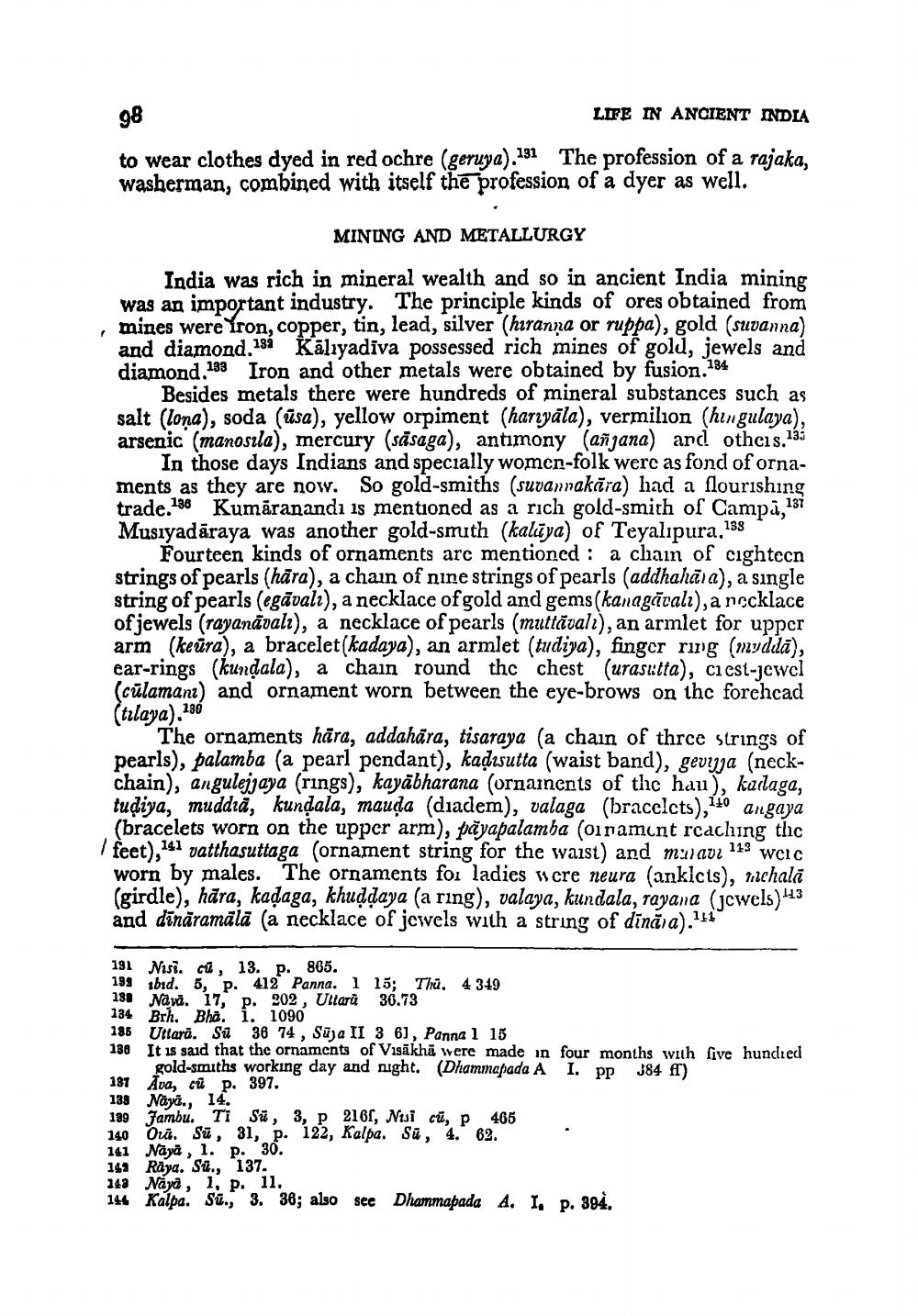________________
98
LIFE IN ANCIENT INDIA
to wear clothes dyed in red ochre (geruya).131 The profession of a rajaka, washerman, combined with itself the profession of a dyer as well.
MINING AND METALLURGY
India was rich in mineral wealth and so in ancient India mining was an important industry. The principle kinds of ores obtained from mines were ron, copper, tin, lead, silver (hiranna or ruppa), gold (suvanna) and diamond.131 Kālıyadīva possessed rich mines of gold, jewels and diamond.103 Iron and other metals were obtained by fusion.134
Besides metals there were hundreds of mineral substances such as salt (lona), soda (usa), yellow orpiment (harıyāla), vermilion (hingulaya), arsenic (manosila), mercury (sāsaga), antimony (añgana) and otheis.133
In those days Indians and specially women-folk were as fond of ornaments as they are now. So gold-smiths (suvannakära) had a flourishing trade.136 Kumāranandı is mentioned as a rich gold-smith of Campà,137 Musiyadāraya was another gold-smith (kalaya) of Teyalıpura,138
Fourteen kinds of ornaments are mentioned : a chain of cightecn strings of pearls (hāra), a chain of nine strings of pearls (addhahāla), a single string of pearls (egāvali), a necklace of gold and gems(kanagavalı), a necklace of jewels (rayanādalı), a necklace of pearls (muttavali), an armlet for upper arm (keūra), a bracelet(kadaya), an armlet (tudiya), finger rig (muddā), ear-rings (kundala), a chain round thc chest (urasitta), ci est-jewel (cülamanz) and ornament worn between the eye-brows on the forehcad (trlaya). 130
The ornaments hāra, addahāra, tisaraya (a chain of three strings of pearls), palamba (a pearl pendant), kadısutta (waist band), gevizja (neckchain), angulejjaya (rings), kayābharana (ornainents of the hau), karlaga, tudiya, muddra, kundala, mauda (diadem), valaga (bracelcts),140 angaya
(bracelets worn on the upper arm), påyapalamba (oinament reaching the I feet),141 vatthasuttaga (ornament string for the waist) and m avz 119 weic worn by males. The ornaments foi ladies were neura (anklcts), chalā (girdle), hāra, kadaga, khuddaya (a ring), valaya, kundala, rayana (cwels) 3 and dināramālā (a necklace of jewels with a string of dināra)."
191 Nisi.cí, 13. p. 865. 199 ibid. 5, p. 412 Panna. 1 15; Trū4 319 131 Navā. 17, p. 202, Ultarà 36.73 134 Brh. Bha. i. 1090 186 Uttari. Su 36 74 , Süja II 3 61, Panna l 15 136 It is said that the ornaments of Visākhā were made in four months with five hundied
gold-smiths working day and night. (Dhammapada A I. pp 384 ff) 181 Ava, ců p. 397. 138 Nāyī., 14. 189 Jambu. Ti S , 3, P 216f, tui cũ, p 465 140 Dr. Sū, 31, p. 19 2, Kalpa. Sü, 4. 62. 141 Naya, 1. p. 30. 142 Raya. Si., 137. 143 Náya, 1, p. 11. 144 Kalpa. Sú.; 3.36; also see Dhammapada A. I, p. 394,




